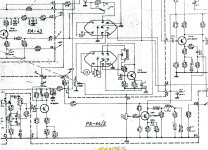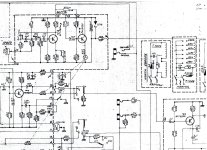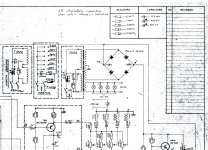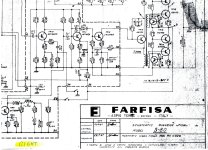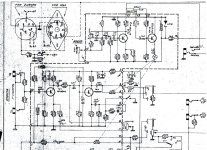A few weeks ago I found this random cabinet in a dumpster that somebody alerted me to. It was a pristine farfisa cabinet for a br-80 amp combo. A whopping 80 watts of Italian made germanium-powered instrument amplifier, with a very nice pristine JBL d130 in the cabinet along with a tell Ray oil can Echo unit. I found the actual head unit on reverb in non-functional condition. I bought it and had it mailed to me and got it functioning straight away. A few weeks later I got an actual schematic and went about shoring up any other Loose Ends. I now have the unit as restored as can possibly be, thankfully to my large collection of germanium transistors that I've accumulated over the years. But it still has a rather present 120 Hertz hum, which is entirely from the power unit, as with all of the inputs shorted or even with the input cards removed the home is still there. I realize there is a lot of possible reasons for this. For instance that this was a unit made for 110 volts now getting closer to 120, and the age of the amplifier possibly having some incongruities. I figured there has to be some way to balance the hum, as I have seen on a lot of other amplifiers. I recapped the whole thing, or at least every electrolytic that was in it. I read some post somewhere that said that the Falcon caps that were in these things were usually pretty stable. That's complete nonsense by the way! Any capacitor from 1967 that I know of is in no way stable! Certainly not in an 80 watt monster from this era. There were very few solid state professional amplifiers back then that were 80 Watts. I'm wondering if they were limited by the state of the capacitor technology of the time, or the state of tech in Europe and Italy to be specific. If made nowadays if they would have capacitors with several thousands of microfarads versus the highest being I believe 1,000 or 2,000 in a preamp circuit. I think most of the larger capacitors in the power amp were only about 500 to 1,000. And a lot of those were hooked up in series with others which would make them lower. I'll include a few pictures and a YouTube link and the schematic that I scoured the planet to find! Thanks for all of your help and information in advance, though I know this is kind of a big ask! Also I'm trying to figure out how to turn one of the record heads in the Echo unit into an erase head, as I have heard of erase heads in these, but not being tape oriented I'm not sure what any race head would be!? I don't even know how they bias the record heads on this particular unit beings it is recorded via electrostatic energy and the regenerated Echo is gotten by simply not being erased entirely on the first pass. This unit is also significantly brighter than the others I've heard, and I made it even more so by speeding it up a little bit by increasing the width of the motor Drive pulley.
Attachments
-
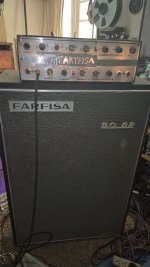 20250412_161441.jpg651.1 KB · Views: 136
20250412_161441.jpg651.1 KB · Views: 136 -
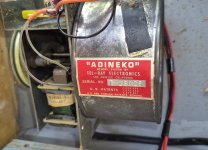 20250316_152818.jpg486.8 KB · Views: 89
20250316_152818.jpg486.8 KB · Views: 89 -
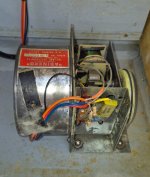 20250316_152812.jpg498.3 KB · Views: 89
20250316_152812.jpg498.3 KB · Views: 89 -
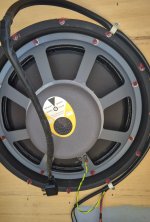 20250316_152808.jpg420.1 KB · Views: 92
20250316_152808.jpg420.1 KB · Views: 92 -
 20250316_152900.jpg375.6 KB · Views: 84
20250316_152900.jpg375.6 KB · Views: 84 -
 20250316_151330.jpg735 KB · Views: 74
20250316_151330.jpg735 KB · Views: 74 -
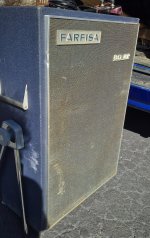 20250316_151300.jpg922.1 KB · Views: 78
20250316_151300.jpg922.1 KB · Views: 78 -
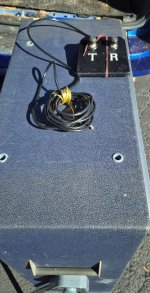 20250316_151254.jpg685.9 KB · Views: 82
20250316_151254.jpg685.9 KB · Views: 82 -
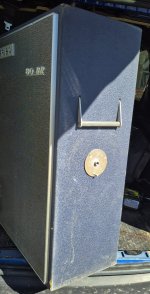 20250316_151018.jpg663 KB · Views: 123
20250316_151018.jpg663 KB · Views: 123 -
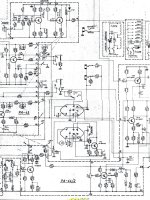 PSX_20250408_050320.jpg322.1 KB · Views: 133
PSX_20250408_050320.jpg322.1 KB · Views: 133
JBL D-130 !! and a oil can delay in the trash !!! WOW good find.
whoever put it in the trash should rethink their lives completely.
Now with google stuff like this doesn't always go in the trash.
Hum could be ground loops, input jack usually grounded to chassis and output jacks.
big old loop sometimes. The so called " death caps" get removed they hum even more.
Can put the death cap back in using line rated X2 capacitor.
People can call them what they are, noise remover cap.
Or rectifier giving out, seems you changed the main caps?
Check solder joints or traces, probe and push around with a chop stick to find loose connections
Depends on oil can model dont think they had erase heads, my morley oil can had feedback control
like typical delay. Should be a site for oil cans, can check the oil or add fresh stuff to wake it up.
For a long long time it was a mystery what it was. And people added all kinds of stuff like wd40 or sewing machine oil.
No no no dont ever do that, will ruin the disk. right fluid made by Ucon , LB-65 oil. Some conductive oil for aerospace.
You had to buy 50 gallons of it. Some group figured out a way to finally get a gallon or so, And sell small amounts to refill the cans.
Far as I understand, spinning disk gets thin coat of oil, the conductive oil similiar to magnetic tape recording, self erases after a few spins.
Some had set delay others had a knob which physically moved the head in the can, external circuits can add feedback for repeats like typical
analog delay. others where just preset for a more reverb type effect.
whoever put it in the trash should rethink their lives completely.
Now with google stuff like this doesn't always go in the trash.
Hum could be ground loops, input jack usually grounded to chassis and output jacks.
big old loop sometimes. The so called " death caps" get removed they hum even more.
Can put the death cap back in using line rated X2 capacitor.
People can call them what they are, noise remover cap.
Or rectifier giving out, seems you changed the main caps?
Check solder joints or traces, probe and push around with a chop stick to find loose connections
Depends on oil can model dont think they had erase heads, my morley oil can had feedback control
like typical delay. Should be a site for oil cans, can check the oil or add fresh stuff to wake it up.
For a long long time it was a mystery what it was. And people added all kinds of stuff like wd40 or sewing machine oil.
No no no dont ever do that, will ruin the disk. right fluid made by Ucon , LB-65 oil. Some conductive oil for aerospace.
You had to buy 50 gallons of it. Some group figured out a way to finally get a gallon or so, And sell small amounts to refill the cans.
Far as I understand, spinning disk gets thin coat of oil, the conductive oil similiar to magnetic tape recording, self erases after a few spins.
Some had set delay others had a knob which physically moved the head in the can, external circuits can add feedback for repeats like typical
analog delay. others where just preset for a more reverb type effect.
Last edited:
I have been on the oil can sites, but I've since heard from other members that the erase heads were not exactly effective on these. Probably because the actual contact between the heads and the disc is not intimate but through the oil and rather random at that. I'm kind of lucky that mine gets the frequency response that it does, as most of them are very dark sounding. I sped up the speed of the disc with the motor run pulley, adding a little more mass to it. As for the hum, it is definitely the power amp causing it. Not sure if this one had a death cab or not, it seems to have had a three-prong power input, although the ground wire was terminated when I found it. The rectifier is new as I removed the old one which was silicon, but ancient, with lots of cooling fins on it which wouldn't really be necessary these days, and put in a full wave rectifier, as the original was. That seemed to calm it down a little bit, but there still is an obvious 120 hertz. But with no master volume, that 80 watt amplifier is always coming through with full potential. Not that a typical amp wouldn't be that way either but, it seems like it's a little bit more primitive. Just not sure on this one. I have a feeling that there's something out of balance perhaps, maybe likely the outputs themselves! I'm not sure if adding more capacitance would help or make it worse. Do you think this thing would have had some kind of noise filtering death cap sort of thing just for the sake of quieting it down? I've got the schematics but they're in pieces. I can put the pieces up I suppose LOL.
Attachments
And yeah, I'm aware of most of the oil can lore, and beings that this was hermetically sealed in a speaker cab, it had all the original seals in tact, and all the original oil. I added a little 65w pag oil, and that made it work. Too well! The delay regenerates over and over. If you check the video link I left up there, you can hear it and it's very bright, and it seems to linger forever sometimes. Maybe the mixture I have in there is a little too insulative, and the charge stays on the disc too long! But I'm not quite sure how to make it stop saving the charge as most of the time people have a problem with just the opposite. One fellow in one of these sites said that if I were to add a few drops of water to the mixture, it would release some of the insulating effects and that perhaps mine had because of the perfect seals, never absorbed atmospheric moisture, because the l65 oil that they used originally was water soluble and would literally attract water out of the air, and that that was the reason that the charge could be stored and then released, because the oil is a dielectric which is an insulator by its nature, but the molecules of water within the oil are what releases the charge. I'm kind of thinking out loud here. Just because I'm a little bit reticent to throw a few drops of water in the thing! It's in such perfect shape! But if that made it Echo last long, I guess it's worth a try!
I would kind of like to hear another working version of that amplifier. If I could hear another one that made this particular level of hum then I would know it's more or less normal. Germanium amplifiers were never really considered that amazing. And given how loud this thing gets, it could very well just have that inherent noise in it. I can think of almost no amplifier out there that ever used all germanium preamp and outputs that reached 80 Watts or even near that. And it sure as hell reaches it! The only amp I know of besides is the early Mark 1 Fender Rhodes suitcase amps. While mostly silicon in the preamp and driver Stage, the outputs on those were all germanium, so a lot of time is when they go down, they stay down! I'm lucky that this one is working as well as it is, I suppose. Although I never could get the vibrato to work!
I would kind of like to hear another working version of that amplifier. If I could hear another one that made this particular level of hum then I would know it's more or less normal. Germanium amplifiers were never really considered that amazing. And given how loud this thing gets, it could very well just have that inherent noise in it. I can think of almost no amplifier out there that ever used all germanium preamp and outputs that reached 80 Watts or even near that. And it sure as hell reaches it! The only amp I know of besides is the early Mark 1 Fender Rhodes suitcase amps. While mostly silicon in the preamp and driver Stage, the outputs on those were all germanium, so a lot of time is when they go down, they stay down! I'm lucky that this one is working as well as it is, I suppose. Although I never could get the vibrato to work!
I never even knew that a GERMANIUM amp of that power was ever manufactured 😳
I remember as a kid being amazed at the 10 watt rating of a 2N301.
I guess that if you use enough power transistors > the sky's the limit.
What are the output transistors ?
I remember as a kid being amazed at the 10 watt rating of a 2N301.
I guess that if you use enough power transistors > the sky's the limit.
What are the output transistors ?
Schematic shows AU103 being used as driver and output. It’s almost the classic transformer-driven totem pole output stage. Interesting twist - the output stage is a stacked series stage like on the Ampzilla. So they started doing that before they even had silicon, let alone PNP silicon. That would get you in the 70V, maybe 80V range on the supply - which would get you 80W at 4 ohms. With strong enough transistors. A regular classic Ge stage is limited to about 40V due to poor second breakdown capability of Ge.
Yeah, i was surprised that it lived up to it, even all these years later. I didn't have to replace the outputs, just caps and a few preamp stages. The noises it made before being fully on line were pretty epic! The head looked like a haunted house! Like a crypt, with lots of old Falcon caps in their final death poses, bloated, leaking, split. Carnage! Old, very smelly carnage! Lol
If you like electrolytic cap smell, try selenium rectifier smell. About as toxic as beryllium, and P-U. With amps like this you usually just replace ALL electrolytics. I’ll give old Sprague’s a chance at least (some hold up surprisingly well).
Those old classic Ge output stages aren’t what usually fails. With that driver transformer it is well isolated from everything else which usually does fail. Most often I see a dead driver - but here they used the same as the output type giving it a lot of design margin.
Those old classic Ge output stages aren’t what usually fails. With that driver transformer it is well isolated from everything else which usually does fail. Most often I see a dead driver - but here they used the same as the output type giving it a lot of design margin.
I got a small wiff of selenium over last weekend, accidentally heated up a very small one with a torch, working on a 50s tube prramp, and opened the windows at first smell, not aware of how toxic that could be, as it was just the tiniest glance with a small butane torch. But YEAH. Even at the tiniest level, it was like cruising down a mountain road in a semi, when the brake rotors start to glow red, with brake pads made of compressed short hairs... of weasels... lol.
I used to be a union laborer. One of those jobs that I had that spurred my brain on to "think of something quick!" I had one of the Cherry positions, that being someone on the team that rebuilt Steel ovens, and demolished them. It was like being stuck in a Steinbeck novel about the Dust Bowl. Just because the job never ended, and everyone there thought it was literally the best thing that ever happened to them. But injuries of a serious nature were daily occurrences. When I quit the job my family were just incensed over that! I had some trustees in my family for that Union. And I'm sure it was an embarrassment! So they gave the job to one of my cousins. Who promptly died about 6 months later doing the same thing I was doing. Then they didn't talk quite so much! But it's one of those kinds of jobs! There were people just getting injured with the kinds of things that they would carry the rest of their lives. And being a musician, and until I started there, climbing the upwardly mobile ladder in that profession quickly... but while we were there building these things, which were never finished there was always another one starting before that one we were working on was finished. One day we're down in the hole, the oven which is turned off approximately 2 weeks before you get down into it. 2 weeks from when it was at a level where it would easily melt slag and steal into Molten product and byproduct. When we were all working one night and the ground underneath us, lurched up 3 inched, and lofted us gently up in the air another 8 inches as we watched every one in the furnace pogo up and gently back down, all mildly concerned. With the older guys looking more worried. One said uh oh. Just as the sound that generated the shock wave caught up with it, 3 seconds later. A slag explosion. Meaning a steam bubble had formed in the slag heap. This one killed the hopper truck driver. As he dumped a load of fresh slag down the mountain of it, the steam filled blister exploded, shearing off the air brake lines with rocket propelled molten fresh slag shooting straight up, into the vehicle, twice as large as the average house, rendering it immobile, as the brakes slammed shut, with no chance of opening... as the exposion likely was similar to re-entering the earths radiation belts in a space craft made of cardboard. This was the thing that made me realize there is no job worth THAT. LATER, that night, a kid who could have easily been a world class bodybuilder, was being used to catch 70 pound carbon bricks. Took a little too long to steady one and had his forefinger and thumb joint/knuckle pulverized by the next block. Against the previous. He was back, later that week in a big cast, enjoying his recovery, working with his good arm. Something that wasn't stated, but considered good form amongst the workers there. He never regained motion in those digits... he counted himself as lucky. I did too, when I stayed home the next day. And the following ones. Lol.
So getting sixty hertzed or having a capacitor go bang right next to you doesn’t even faze you, right?
I spent the whole day building a custom leslie for a church. I would say I'm pretty phased. Lol. Knackered and biffed. But I'm restoring a mellotron, and i wanna hear my new farmyard samples tape set, with the last note, a rare recording of CSNY NOT fighting in the dressing room at Fillmore east. After the F# Donkey braying. Plus i found some stuff in an old gate fold copy of Fragile, not sure what it was, but everything tastes purple now.
- Home
- Amplifiers
- Solid State
- 1967 all germanium Farfisa BR 80, 80 w head unit fully restored now, but still yielding rather loud 120 HZ hum

